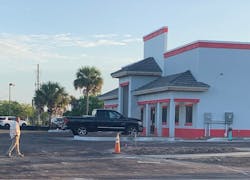The shipping crisis is impacting tire dealers across the United States. Darrin Mallet, owner, Kilgore Tire Center in Kilgore, Texas, says he doesn’t order a lot of containers -“three or four a year, maybe five.” But most of the containers he has ordered within the last 12 months have been delayed.
“I had one that was supposed to come in at the end of last month and we now have no date” on when it will arrive.
“It could be three weeks from now. It could be another month from now. We’re used to having a steady supply. But that’s been disrupted.”
He also is wrestling with escalating freight rates.
“I ordered a container in July of last year and got it in October. All the shipping costs were (factored in) with the container. The price of the tires basically covered the shipping cost.
“I turned around and ordered another container and received it at the end of February 2021.” It came with a $1,500 surcharge.
Mallett has been hit with additional surcharges -up to $4,000 in a recent case -forcing him to pass costs along to his customers. “We have to,” he says.
Joe Ramsay, president of Pit Stop Auto Repair, a seven-store chain based in Venice, Fla., says the shipping slowdown has hit his dealership particularly hard within the last three months.
“Different models and brands come and go,” particularly at the tier-four level, he explains.
“It’s hit or miss, depending on the size and who has it that day. You get what you can get sometimes.”
Domestic tiremaker price hikes have complicated matters.
“It’s made for a really interesting time in the market,” he says. “‘I’ve told all of my managers, ‘Sell what you can get.’ We’ve probably been less brand-loyal over the last several months than we’ve ever been in the past.
“I’m not a ‘sky is falling’ guy, but it is concerning,” he says.
Steve Paden, owner of Elite Tire & Auto, a single-store dealership in Modesto, Calif., buys most of his tires from a wholesale distributor, which communicates with off-shore manufacturers. “I don’t have hands-on experience” working directly with factories, he says.
“But the thing I can speak to is checking on inventories on a product you’ve been selling your whole career and then all of a sudden, that product is not available.”
Most of Paden’s customers opt for lower-priced tires.
“And those are the tires that have been the most impacted” by the shipping crisis. “They are drying up.”
Like other dealers, he’s been forced to pass freight rate increases onto his customers in the form of elevated retail prices.
“Over the last six months, we’ve had to hike (prices by) about $100 per set of tires, on average. A set that was going for $399 is now (selling for) $499.
“The kick with that is you think you’re making more money. But the reality is, you’re making the same amount.”
The shipping slowdown is affecting bigger dealerships, too. Beth Barron, CEO of Morgan City, La.-based Chabill’s Tire Service LLC, which has 18 locations, had been ordering medium truck tires from an overseas supplier.
“We got an email saying, ‘Every container will be an extra $3,000.’
“I wasn’t surprised because I’d been hearing all the rumors” about freight rate spikes, she says. “But it took us out of buying that product. It didn’t make sense to take on all that inventory when we can buy something from a local wholesaler for around the same price.”
Scott Mulvey, owner of Hoffman Automotive Tire Pros, a single-store dealership in Fayetteville, Ga., says the slowdown has extended to ground logistics providers, which is hurting his company.
Mulvey notes that his primary supplier, American Tire Distributors Inc., has been consistent with deliveries. But he can’t say the same for outside shipping companies that he has occasionally used.
Justin Hall, service writer at Wilmington Tire & Auto in Wilmington, N.C., says “there are shortages across the board” and it’s been harder for his dealership to get product overall.
“I’m even talking about domestic tires. You’re limited in your selection.”


